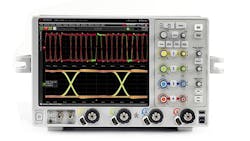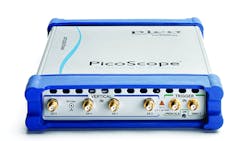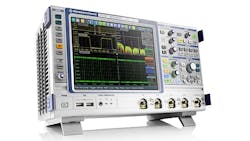6 Digital Oscilloscopes For Testing High-Speed Communications
As electronic devices are built with an increasing number of radio frequency and digital components, test equipment is starting to incorporate a more advanced set of measurement tools for high-speed communications signals. Digital oscilloscopes, widely considered the center of the lab bench, have not avoided this wave of integration. The latest models are being designed with built-in waveform generators, logic analyzers, and serial protocol and spectrum analysis functions.
The modern oscilloscope is no longer just a time-domain measurement tool. It has evolved to make the frequency-domain measurements necessary for validating and debugging signals from wireless communications systems, including Long-Term Evolution (LTE) and wireless local area networks (WLANs). It performs these measurements using either Fast Fourier Transform (FFT) functions or spectrum analysis software, enhanced by the wide range of test functions built into the instrument.
In some cases, a digital oscilloscope might be preferable to a frequency-domain instrument such as a signal analyzer for testing RF communications signals. This is especially true for newly emerging ultra-wideband (UWB) communications systems, which allocate frequencies from 3.1 to 10.6 GHz and reach data rates up to 1024 Mbits/s. While a signal analyzer exhibits better dynamic range and less distortion, modern oscilloscopes have the benefit of higher measurement bandwidths and more automated functions for signal analysis.
Here are six of the latest digital oscilloscopes with frequency-domain functions for testing communications-based components:
1. Keysight Technologies Infiniium V-Series Oscilloscopes
The Infiniium V-Series Oscilloscope from Keysight Technologies provides a wide range of measurement bandwidths from 8 GHz to 33 GHz with four analog channels standard on all models. The highest bandwidth model, the DSAV334A sampling oscilloscope, runs with 33 GHz and a real-time sample rate of 80 GS/s over two channels, and 40 GS/s over four channels. The instrument supports a noise floor of 2.10 mVrms with 50 mV/div sensitivity, and a jitter measurement floor lower than 100 fs.
The DSA334A oscilloscope features 100 Mpts of depth memory per channel and a 12.5 Gbps hardware serial trigger with a 160-bit sequence. For frequency-domain measurements, the it provides an FFT function that enable users to make wideband measurements up to 33 GHz - which can be increased by combining the instrument with a down converter circuit. An effective number of bits (ENOB) more than 5.5 and Spurious Frequency Dynamic Range (SFDR) greater than 50 dBC serve to enhance the dynamic range of its spectrum analysis functions.
The probing system for Infiniium V-Series oscilloscopes supports browsing up to 30 GHz and can be upgraded for increasing measurement requirements. A wide range of software updates enables the oscilloscope to measure the specifications of LPDDR4, HDMI 2.0, 100G Ethernet, and MIPI standards. Also available in this series is a 33 GHz mixed-signal oscilloscope (MSO) that accepts 16 digital channels, in addition to four analog inputs.
2. Tektronix DPO70000SX Performance Oscilloscope
The DPO70000SX Performance Oscilloscope from Tektronix provides a real-time measurement bandwidth of 70GHz and a 200 GS/s sample rate with 5 ps sample resolution. Contained in a compact package, the oscilloscope can be linked with other oscilloscope modules to increase the number of available channels, while holding channel-to-channel jitter to below 500 fs.
Coupled with SignalVu Vector Analysis software, this oscilloscope is capable of analyzing wideband RF signals such as radar, optical coherent networks, EW, or WLAN 802.11ac. With the oscilloscope operating at its full trigger capacity, the software provides the functions of a real-time signal analyzer, including vector signal analysis, pulse analysis, Bluetooth or WLAN tests, and spectrum analysis functions.
These models are available in single-unit systems, which support up to 70 GHz bandwidth over one channel, 33 GHz bandwidth over two channels, and 23 GHz bandwidth over four channels – or a two-unit system that opens twice as many channels for each bandwidth. The system operates through Asynchronous Time Interleaving (ATI), a process developed by Tektronix using silicon germanium (SiGe) semiconductors from IBM. The oscilloscope breaks down input signals, coverts them into digital format using an analog-to-digital converter (ADC), and then reconstructs them into real-time measurements for wide bandwidth signals.
3. Pico Technology Picoscope 9341 Sampling Oscilloscope
Designed to analyze two differential or four single-ended high speed signals, the Picoscope 9341 Sampling Oscilloscope provides bandwidth up to 20 GHz for testing data rates up to 40 Gb/s. This PC-based instrument from Pico Technology features a 17.5 ps input rise time, 14 GHz trigger bandwidth, and dual-channel samplers with 16-bit, 60 dB dynamic range analog-to-digital converters (ADCs). With the instrument operating at full measurement bandwidth, the typical input noise is mV RMS with trigger jitter of 1.8 ps.
Using software compatible with Microsoft Windows XP through Windows 8.1, this compact oscilloscope plugs into a computer using a LAN or USB interface. The software includes 61 math functions, 138 automatic measurements, and 167 standard communications masks from 1.54 Mb/s to 12.5 Gb/s. Equipped with spectrum-mode measurements, it also provides 5th-harmonic characterization up to 8 Gb/s.
This model can be used for for pre-compliance tests, fault-finding, and margin testing on serial data signals such as 10 Gb Ethernet, SONET/SDH STM64 and FEC1071, 10x Fibre Channel, and Infiniband. It also measures skew and crosstalk between differential pairs on serial buses such as HDMI, SATA, and PCIe. The 9.5-GHz optical-to-electric converter built into the oscilloscope is configured for testing standard optical communications signals, and a built-in signal generator is available for testing device inputs.
4. Fluke Scopemeter 190-504 Series II Oscilloscope
Spectrum analysis functions have also found their way into portable oscilloscopes. The latest addition to Fluke’s line of handheld oscilloscopes, the Scopemeter 190-504 Series II provides measurement bandwidth of 500 MHz and a 5 GS/s real-time sample rate. Supporting frequency-domain analysis with an FFT function, the instrument is capable of testing communications, navigational, and military devices. The instrument comes with two or four independently insulated input channels and memory depth up to 10,000 samples per channel.
In terms of capturing waveform phenomena, such as transients and induced noise, the Scopemeter 190-504 is equipped with a 200 ps resolution and an automatic triggering system for fast, slow, and complex signals. On the side of the module is a USB port for PC connectivity and memory devices. As a handheld model developed for use outside the laboratory, the oscilloscope is rated to withstand dust, drips, humidity, and wide temperature variations.
5. Teledyne Lecroy LabMaster 10 Zi-A Series Digital Oscilloscope
The latest real-time oscilloscope from Teledyne Lecroy, the LabMaster 10 Zi-A provides a high measurement bandwidth for testing next-generation electrical and optical fiber communication links. The flagship model provides up to 100 GHz of bandwidth and a maximum sample rate of 240 GS/s. Designed with a low jitter measurement floor and a 14.1 Gb/s hardware serial trigger, the instrument’s sample clock has an intrinsic jitter of only 50 fs RMS. It also features a 3.5 ps rise time and memory depth of 1024 Mpts per channel.
A single acquisition module supports four channels at 36 GHz and two channels at 65 GHz. But it can also be linked to other LabMaster 10 Zi-A modules to vastly increase the number of available inputs, while reducing the jitter between measurement channels. Multi-unit systems are able to support up to 80 channels at 36 GHz by linking 20 additional modules, with less than 130 fs of channel-to-channel jitter.
The highly modular design, long memory, and high measurement bandwidth are aimed at testing both serial and RF communications signals. It is capable of measuring 10-16 Gb/s standards as well as ultra-high speed technologies, such as CEI-25/28, CEI-56, and coherent optical formats including DP-QPSK, 16-QAM, and MIMO.
6. Rohde & Schwarz RTE Series Digital Oscilloscopes
Rohde & Schwarz has extended its series of R&S RTE Digital Oscilloscopes to include a model with measurement bandwidth up to 2 GHz, the R&S RTE 1204. Available with two or four input channels, the unit features a sample rate of 5 GS/s with an acquisition memory of 10 Mpts per channel. The acquisition rate is over one million waveforms per second with 500 μV/div sensitivity at the full measurement bandwidth. It also features a rise time of less than 175 ps and a 16-bit resolution.
The R&S RTE 1204 model is equipped with an FFT function, integrated on the hardware level, which allows operators to measure total harmonic distortion (THD) and power spectrum density (PSD) of high speed RF signals. An RMS noise of 100 µV at 1 GHz bandwidth and an effective number of bits in excess of 7.0 serve to increase the dynamic range for spectrum analysis.
While not yet available on the 2 GHz model, Rohde & Schwarz recently upgraded its 1 GHz RTE Series oscilloscope with a spectrum analysis and spectrogram option, which enables users to analyze time-domain, spectrum, protocol, and logic signals simultaneously. For testing embedded designs, the R&S RTE series is available with an MSO option, featuring up to 400 MHz bandwidth and 16 input channels.
About the Author
James Morra
Senior Editor
James Morra is the senior editor for Electronic Design, covering the semiconductor industry and new technology trends, with a focus on power electronics and power management. He also reports on the business behind electrical engineering, including the electronics supply chain. He joined Electronic Design in 2015 and is based in Chicago, Illinois.




